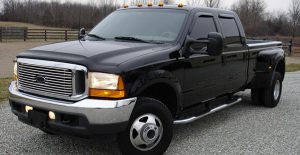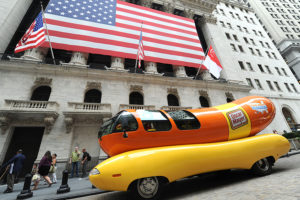Things You Didn’t Know About the History of the U.S. Interstate System

You’ve driven on them your whole life, zipping from state to state on family vacations or just commuting to work. The U.S. Interstate System is such a fundamental part of American life that we rarely give it a second thought. But beneath that familiar blacktop lies a story filled with military strategy, political wrangling, and some truly bizarre details you probably never learned in history class.
From secret Cold War plans to mind-boggling engineering feats, the history of our national highway network is more fascinating than you might imagine. Get ready to look at those green and white mile markers in a whole new light. Here are 20 things you didn’t know about the history of the U.S. Interstate System.
1. It Was Inspired by a Disastrous Cross-Country Road Trip
Before he was a five-star general and president, a young Dwight D. Eisenhower participated in the U.S. Army’s first transcontinental motor convoy in 1919. The goal was to see how quickly military vehicles could move across the country. The answer? Not very fast. The convoy of 81 vehicles crawled from Washington, D.C., to San Francisco at an average speed of just 5 miles per hour. They faced impassable mud, rickety wooden bridges, and roads that were little more than dirt paths.
This grueling 62-day journey stuck with Eisenhower. He saw firsthand that America’s pathetic road system was a national security liability. The experience planted the seed for a national highway network, proving that sometimes the worst road trips can lead to the biggest ideas.
2. Hitler’s Autobahn Was a Major Influence
During World War II, Eisenhower got another major dose of highway inspiration, this time from an unlikely source: Nazi Germany. As the Supreme Allied Commander, he was blown away by the efficiency of Germany’s Autobahn system. He saw how the network of high-speed, limited-access roads allowed troops and supplies to move with incredible speed. It was a logistical marvel that gave the German military a significant advantage.
When Eisenhower became president, he was determined to build something similar, but better, in the United States. He envisioned a system that would not only bolster national defense but also connect the country for commerce and travel like never before. The Autobahn provided a powerful, real-world example of what a modern highway system could achieve.
3. It Was Officially a National Defense Project
While we know the interstates for road trips and daily commutes, their official name tells the real story: The Dwight D. Eisenhower National System of Interstate and Defense Highways. The 1956 Federal-Aid Highway Act, which created the system, was passed during the height of the Cold War. The primary justification for the massive $25 billion price tag was national defense.
The idea was that these highways would allow for the rapid deployment of troops and military equipment in the event of a foreign invasion. They were also designed to facilitate the evacuation of cities in case of a nuclear attack. So, the next time you’re stuck in traffic on I-95, just remember: you’re on a piece of critical Cold War infrastructure.
4. The “One-in-Five Miles” Rule Is a Myth
You’ve probably heard this one: “One out of every five miles of the Interstate System is straight so it can be used as an emergency runway for military aircraft.” It’s a great story, blending Cold War paranoia with clever engineering, but it’s completely false. There is no law or regulation that requires any portion of the interstate to double as a runway.
While the military could certainly land a plane on a long, straight stretch of highway in a dire emergency, the system wasn’t designed for it. The roads lack the necessary thickness to handle the weight of many military transport planes, and they’re cluttered with things like light poles, medians, and overhead signs. The myth likely grew out of the system’s defense-oriented origins.
5. There’s a Secret, Unmarked Interstate
One well-known example is Interstate H-201 in Hawaii. For years, this highway was signed only as State Route 78, even though it was built to interstate standards and is officially part of the system. The reason? To keep local drivers from getting confused by a new interstate number. Highways like H-201 are unmarked as interstates but still serve all the functions of one, connecting key areas while benefiting from federal funding.
These hidden or “secret” interstates are officially part of the system behind the scenes—just without the usual signage.
6. The Numbering System Isn’t Random
Ever wonder why I-5 runs along the West Coast and I-95 hugs the East Coast? There’s a logical system behind the numbers. Major north-south routes are given odd numbers, starting with I-5 in the west and increasing as you move east. Major east-west routes get even numbers, starting with I-10 in the south and increasing as you head north to I-90.
Connecting loops and spurs that branch off the main routes are given three-digit numbers. If the first digit is even, it’s a beltway or loop that connects back to the interstate at both ends (like I-285 around Atlanta). If the first digit is odd, it’s a spur that branches off into a city (like I-395 in Washington, D.C.). It’s a beautifully simple system designed to help you know where you are and where you’re going.
7. It Has Almost No Stoplights
One of the defining features of the Interstate System is that it’s designed for continuous, high-speed travel. This is achieved through the concept of “controlled access,” which means there are no intersections, traffic signals, or railroad crossings. Every road that crosses an interstate either goes over or under it, and you can only get on or off at designated interchanges.
This design is what allows you to set your cruise control and drive for hours without stopping. While a few rare exceptions and grandfathered-in intersections exist, the overwhelming majority of the 48,000-mile system is free of stoplights. It’s a core principle that makes the interstate a model of efficiency.
8. The Federal Government Paid for 90% of It
Building a 48,000-mile highway system is not cheap. To make it happen, the federal government made the states an offer they couldn’t refuse. The 1956 Highway Act stipulated that the federal government would cover 90% of the construction costs, with the states picking up the remaining 10%. This was a huge incentive for states to get on board.
To pay for its share, the federal government created the Highway Trust Fund, which was funded by a national tax on gasoline. This “pay-as-you-go” system ensured that the people who used the roads were the ones who paid for them. It was one of the largest public works projects in history, and this funding model made it all possible.
9. It Has Its Own Set of Design Standards
Every single mile of the Interstate System was built to a strict set of federal standards. These rules dictate everything from the width of the lanes (12 feet) and the height of overpasses (a minimum of 16 feet) to the grade of the hills and the curve of the roads. The goal was to create a uniform system where drivers would know exactly what to expect, no matter what state they were in.
These standards were all designed with safety and high-speed travel in mind. Wide lanes, gentle curves, and clear sightlines all contribute to a safer driving experience. This uniformity is a key reason why interstates are statistically the safest roads to travel on.
10. The Last Original Mile Was Completed in 1992
The original plan called for the Interstate System to be completed in about 16 years. It ended up taking 36. The final piece of the originally planned network was a 1.5-mile stretch of I-70 through Glenwood Canyon, Colorado. This section was a monumental engineering challenge, requiring the construction of 40 bridges and viaducts through a narrow, environmentally sensitive canyon.
The project was delayed for years by lawsuits and debates over its environmental impact. When it finally opened in 1992, it marked the symbolic completion of Eisenhower’s grand vision. It was a fittingly dramatic end to one of America’s most ambitious undertakings.
11. Missouri Was the First State to Start Construction
While many states clamor for the title, the historical record shows that Missouri was the first to get shovels in the ground. On August 13, 1956, Missouri awarded the first contract for work on what would become I-70. Just a few weeks later, Kansas became the first state to complete a section of interstate, a stretch of I-70 near Topeka.
This friendly rivalry to be “first” highlights the excitement and national pride that surrounded the project. States were eager to start building their piece of this revolutionary new transportation network, ushering in a new era of American mobility.
12. Some Cities Fought Against It
While most of the country embraced the new highways, not everyone was thrilled. In many cities, the proposed routes cut directly through established, often minority, neighborhoods. This led to massive community opposition, as residents fought to save their homes and communities from the bulldozer.
In cities like New Orleans, San Francisco, and Washington, D.C., citizen activists successfully blocked or rerouted planned interstates. These “freeway revolts” preserved historic neighborhoods and forced planners to reconsider the human cost of urban highway construction. The “road to nowhere” on San Francisco’s Embarcadero, a remnant of a defeated freeway project, stood for years as a monument to one of these successful protests.
13. It Bypassed Thousands of Small Towns
The Interstate System was a blessing for long-distance travelers but a curse for many small towns. The new highways were designed to bypass congested town centers, routing traffic around them instead of through them. This was great for speed but devastating for the mom-and-pop motels, diners, and gas stations that lined the old U.S. highways like Route 66.
Many of these towns, once bustling stops for travelers, withered away as the river of traffic and commerce was diverted. The interstate created a more efficient America, but it also contributed to the decline of a certain slice of small-town life, forever changing the landscape of the American road trip.
14. There Are No Interstates in Alaska or Puerto Rico (Officially)
Despite having highways built with federal interstate funds, Alaska and Puerto Rico are not officially part of the contiguous U.S. system. Their highways are numbered with prefixes like “A-1” in Alaska and “PR-2” in Puerto Rico. They are built to the same standards but are not connected to the main grid, so they don’t get the classic red, white, and blue shield.
Hawaii, on the other hand, does have official interstates (H-1, H-2, and H-3), even though it’s an island. The reasoning is that these highways are essential for connecting military bases on Oahu, fitting the system’s core defense mission. It’s a perfect example of bureaucratic logic.
15. The Mile Markers Start at State Lines
Ever notice how the mile markers on an interstate reset when you cross into a new state? The numbering system starts at the southern or western border of each state. So, if you’re driving north on I-75 in Florida, the mile markers will start at 1 near Miami and increase as you head toward Georgia. When you cross into Georgia, they reset back to 1.
This system helps with navigation and emergency response, allowing you to pinpoint your location with precision. The exit numbers are also tied to the mile markers. Exit 150, for example, will be located at or very near mile marker 150. It’s a simple but effective way to keep things organized across thousands of miles.
16. It Led to the Rise of Suburbia and Chain Restaurants
The Interstate System didn’t just change how we travel; it changed how we live. The new highways made it possible for people to live farther from their jobs in the city, fueling the explosion of suburban communities in the post-war era. The classic American suburb, with its single-family homes and sprawling lawns, is a direct product of the automobile and the roads that served it.
This new mobility also gave rise to the franchise model for restaurants and hotels. Chains like McDonald’s, Holiday Inn, and Howard Johnson’s popped up at interstate interchanges across the country, offering travelers a consistent, reliable experience no matter where they were. The interstate homogenized the American landscape, for better or for worse.
17. The System Is Technically Not Finished
While the original 1956 plan is complete, the Interstate System continues to grow. Congress has periodically added new routes to the network. For example, I-22 connecting Memphis, Tennessee, and Birmingham, Alabama, was officially designated in 2012.
These additions are usually made to connect important economic centers or to upgrade existing highways to interstate standards. So, while the grand vision of the 1950s has been realized, the system remains a living, evolving piece of infrastructure, adapting to the country’s changing needs.
18. The Color of the Shield Has Meaning
The iconic red, white, and blue shield of the interstate sign was no accident. The colors were chosen to be patriotic and easily recognizable. The design was created by a Texan highway engineer and selected in a national contest.
Interestingly, there’s a special version of the shield for business loops. Business routes, which peel off the main interstate to go through a town’s business district, use a green shield instead of a blue one. It’s a subtle visual cue to let drivers know they are on a side route, not the main highway.
19. It Is Remarkably Safe, Statistically Speaking
Despite the high speeds, driving on the interstate is significantly safer than driving on other roads. According to the Federal Highway Administration, the fatality rate on the Interstate System is less than half the rate for all other roadways.
This superior safety record is a direct result of its design. Features like controlled access, wide lanes, gentle curves, divided highways, and the absence of intersections dramatically reduce the chances of the most common and deadliest types of accidents. It’s a system engineered for safety from the ground up.
20. The Longest Interstate Is I-90
Stretching from Seattle, Washington, to Boston, Massachusetts, I-90 is the king of the interstates. It clocks in at a whopping 3,020 miles, passing through 13 states on its coast-to-coast journey. It follows the path of several historic routes, including the old U.S. Route 10.
Driving the entire length of I-90 would take you through an incredible cross-section of America, from the mountains of the Pacific Northwest, across the Great Plains, through the industrial heartland, and into the historic cities of the Northeast. It is a testament to the scale and ambition of the system, a ribbon of asphalt truly connecting the nation.
Featured image via Michael Ochs Archives/Michael Ochs Archives/Getty Images





